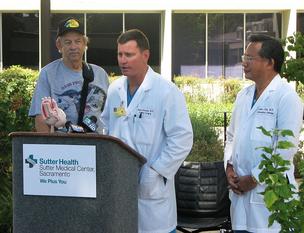Tuesday, August 06, 2013 8:47:42 AM
8-5-13: ”Sutter Uses Smaller Heart Pump (HVAD) to Help Patient Waiting for Transplant”
Kathy Robertson, Sacramento Business Journal
http://www.bizjournals.com/sacramento/news/2013/08/05/sutter-health-uses-heart-pump-patient.html
Ron Walters, 67, is expected to head home later Monday with a small heart pump in his chest that eventually will allow him to resume normal activity while he waits for a transplant.
The new ventricular assist system by HeartWare [“HVAD”] was approved by the U.S. FDA in November 2012. Walters is the first patient to be implanted with the device at Sutter Memorial Hospital, which houses the only heart transplant program in the region.

PHOTO: ”Ron Walters, left, is expected to leave home Monday with a heart pump that will let him resume normal activity while waiting for a heart transplant. Walters is standing with Sutter doctors Robert Kincade and John Chin. This was Sutter's first use of the HeartWare ventricular assist system.”
Because of its [HVAD’s] small size — the device fits into the palm of the hand — the pump is easier to install and the patient recovers faster. This cuts hospital stays and costs. “The advantage is it is quite a bit smaller than previous pumps, so the operation is a little simpler and less invasive,” said Dr. Robert Kincade, surgical director of the Sutter heart transplant program.
The new pump is expensive. Kincade would not say how much; Sutter negotiated a packaged deal. But the higher cost up front is expected to balance over time, as hospital stays go down. Designed for patients with heart failure who are waiting for a transplant, the device also may give patients more time while they wait for a permanent solution, given a limited pool of donors. Kincade estimates 50 to 100 patients annually could benefit from the procedure. Many are going without treatment currently.
Life is not normal for heart failure patients, but the size of the new pump should allow patients to feel better and resume normal activity in a few months, Kincade said. All except swimming and getting into a bathtub, he added. The device has a battery pack and cord. Sutter Memorial is the only local hospital offering the procedure. In the Bay Area, it is available at Stanford and the University of California San Francisco. Sutter launched a ventricular assist device program in 2009 for patients who need therapy but do not qualify for a transplant. Walters is the first local recipient of the new, smaller pump.
*end*
VAYK Discloses Strategic Conversation on Potential Acquisition of $4 Million Home Service Business • VAYK • May 9, 2024 9:00 AM
Bantec's Howco Awarded $4.19 Million Dollar U.S. Department of Defense Contract • BANT • May 8, 2024 10:00 AM
Element79 Gold Corp Successfully Closes Maverick Springs Option Agreement • ELEM • May 8, 2024 9:05 AM
Kona Gold Beverages, Inc. Achieves April Revenues Exceeding $586,000 • KGKG • May 8, 2024 8:30 AM
Epazz plans to spin off Galaxy Batteries Inc. • EPAZ • May 8, 2024 7:05 AM
Moon Equity Holdings, Corp. Announces Acquisition of Wikolo, Inc. • MONI • May 7, 2024 9:48 AM









